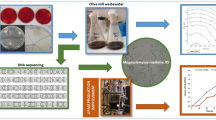Summary
Enterobacteria growing on wastewater from olive oil extraction were selected. Among this microflora, strains of Klebsiella oxytoca and Citrobacter diversus able to degrade simple monomeric aromatic compounds were isolated by enrichment culture of the effluent lacking simple sugars. In this preliminary investigation, the phenolic acids tested on solid and liquid media were gentisic, protocatechuic, p-hydroxybenzoic, benzoic, vanillic and ferulic. It was shown that the biodegradation of an aromatic acid is tightly dependent on both the type and the position of the radical substituted on the aromatic ring. Citrobacter was the most efficient strain in metabolizing ferulic acid in liquid medium at a concentration of 1.5 g/l. The substrate biodegradation yield achieved exceeded 86%.
Similar content being viewed by others
References
G. Aggelis Iconomou D. Christou M. Bokas D. Kotzailias S. Christou G. Tsagou V. S. Papanikolaou (2003) ArticleTitlePhenolic removal in a model olive oil mill wastewater using Pleurotus ostreatus in bioreactor cultures and biological evaluation of the process Water Research 37 3897–3904
E. Ammar A.M. Deschamps J.M. Lebault (1986) ArticleTitleBiodegradation of ammonium sulfite spent liquor by pure bacterial culture Applied Microbiology and Biotechnology 24 122–127
E. Ammar S. Ueno (1999) Connaissances de base pour la lutte contre la pollution des eaux usées Ammar et Ueno Sfax 10–77
C. Argenson S. Régis J.M. Jourdain P. Vaysse (1999) L’olivier CTIFL Paris 163–181
Ben Rouina B., Gargouri K.,Taamallah H.(2001). L’utilisation des margines comme fertilisant en agriculture. In Journées Méditerranéeenes de l’Olivier: Nimes (France) 6–8 Avril.
D. Bosku (1996) Olive Oil Chemistry and Technology AOCS Press Champaign 1–53
M.D. Cameron S. Timofeevski S.D. Aust (2000) ArticleTitleEnzymology of Phanerochaete chrysosporium with respect to the degradation of recalcitrant compounds and xenobiotics Applied Microbiology and Biotechnology 54 751–758
Y.H. Chang C.T. Li M.C. Chang W.K. Shieh (1998) ArticleTitleBatch phenol degradation by Candida tropicalis and its fusant Biotechnology and Bioengineering 60 391–395
E. Ercoli R. Ertola (1983) ArticleTitleSCP production from olive black water Biotechnology Letters 5 457–462
E. Fedeli (1997) Encyclopédie mondiale de l’olivier. Conseil Oléicole International,Plazaa et Janés Barcelona 306–312
J.A. FiestasRosde Ursinos (1966) ArticleTitleEstudio del alpechin para su approvechamiento industrial Grasas y Aceite 2 41–47
N. Gharsallah (1993) ArticleTitleProduction of single cell protein from olive mill waste water by yeasts Environmental Technology 14 391–395
M. Hamdi A. Khadir J.L. Garcia (1991) ArticleTitleThe use of Aspergillus niger for bioconversion of olive oil mill wastewaters Applied Microbiology and Biotechnology 34 828–831
K. Heesche-Wagner T. Schwarz M. Kaufmann (1999) ArticleTitlePhenol degradation by an enterobacterium: a Klebsiella strain carries a TOL-like plasmid and a gene encoding a novel phenol hydroxylase Canadian Journal of Microbiology 45 162–171
C. Hinteregger R. Leitner M. Loidl A. Ferschl F. Streichsbier (1992) ArticleTitleDegradation of phenol and phenolic compounds by Pseudomonas putida EKII Applied Microbiology and Biotechnology 37 252–259
InstitutionalAuthorNameJapan International Cooperation Agency (1993) The Study on Waste Treatment Recycling Plan of Selected Industries in the Region of Sfax in The Republic of Tunisia JICA Tokyo 4-29–4-41
InstitutionalAuthorNameJapan Standards Association (1995) JIS-Handbook: Quality control JIS Tokyo 2347
M. Karapinar J.T. Worgan (1983) ArticleTitleBioprotein production from the waste products of olive oil extraction Journal of Chemical Techology and Biotechnology 33 185–188
T. Kent-Kirk T. Higuchi H. Chang (1981) Lignin Biodegradation Microbiology, Chemistry and Potential Applications Vol.1 CRC Press Florida 104–144
Krieg N.R., Holt J.G. (1983).Bergey’s Manual of Systematic Bacteriology. vol 1, pp. 458–465. Williams & Wilkins: Baltimore. ISBN 0-683-04108-8.
J. Perez A. Ramos-Cormenzana J. Martinez (1990) ArticleTitleBacteria degrading phenolic acids on a polymer phenolic pigment Journal of Applied Bacteriology 69 38–42
J. Rabenhorst (1996) ArticleTitleProduction of methoxyphenol-type natural aromachemicals by biotransformation of eugenol with a new Pseudomonas sp Applied Microbiology and Biotechnology 46 470–474
Ramos-Cormanzana A. (1986). Physical, chemical, microbiological and biochemical characters of vegetation water. In International Symposium on Valorization of Olive By-products: pp. 19–40, FAO, La Caja de Ahorros, Madrid. ISBN 84-505-4814-4.
A. Ramos-Cormanzana M.P. Garcia-Pareja E. Martinez-Nietol S.E. Garrido-Hoyos (1982) ArticleTitlePhenolic compounds biodegradation of olive mill waste water with Aspergillus terrus Grasas y Aceites 43 75–81
K. Randerath (1971) Chromatographie sur couches minces Gauthier-Villars Paris 208–220
C. Richard (1982) ArticleTitleBactériologie et épidémiologie du genre Klebsiella Bulletin de l’Institut Pasteur 80 127–142
E. Sanjust R. Pompei A. Rescigno A. Rinaldi M. Ballero (1991) ArticleTitleOlive milling waste water as a medium for growth of four Pleurotus species Applied Biochemistry and Biotechnology 1 223–235
N. Shivarova P. Zlateva B. Atansov A. Christov N. Peneva M. Guerginova Z. Alexieva (1999) ArticleTitlePhenol utilization by filamentous yeast Trichosporun cutaneum Bioprocess Engineering 20 325–328
B.P. Smith K.M. Tomfohrde D.L. Rohden A. Balows (1972) ArticleTitleApi system: a multitube micromethod of identification of Enterobacteriacea Applied Microbiology 24 449–452
K.J. Tan C.O. Gill (1984) ArticleTitleEffect of culture conditions on batch growth of Saccharomycopsis lipolytica on olive oil Applied Microbiology and Biotechnology 20 201–206
A. Tsioulpas D. Dimou D. Iconomou G. Aggelis (2002) ArticleTitlePhenolic removal in olive mill wastewater by strains of Pleurotus spp. in respect to their phenol oxidase (laccase) activity Bioresource Technology 84 251–257
K. Watanabe M. Teramotoo H. Futama S. Harayama (1998) ArticleTitleMolecular detection, isolation and physiological characterization of functionally dominant phenol-degrading bacteria Applied and Environmental Microbiology 64 4396–4402
N. Zouari R. Ellouz (1996) ArticleTitleMicrobial consortia for the anaerobic degradation of aromatic compounds in olive oil mill effluent Journal of Industrial Microbiology 16 155–162
Author information
Authors and Affiliations
Corresponding author
Rights and permissions
About this article
Cite this article
Ammar, E., Nasri, M. & Medhioub, K. Isolation of Enterobacteria able to degrade simple aromatic compounds from the wastewater from olive oil extraction. World J Microbiol Biotechnol 21, 253–259 (2005). https://doi.org/10.1007/s11274-004-3625-y
Received:
Accepted:
Issue Date:
DOI: https://doi.org/10.1007/s11274-004-3625-y




